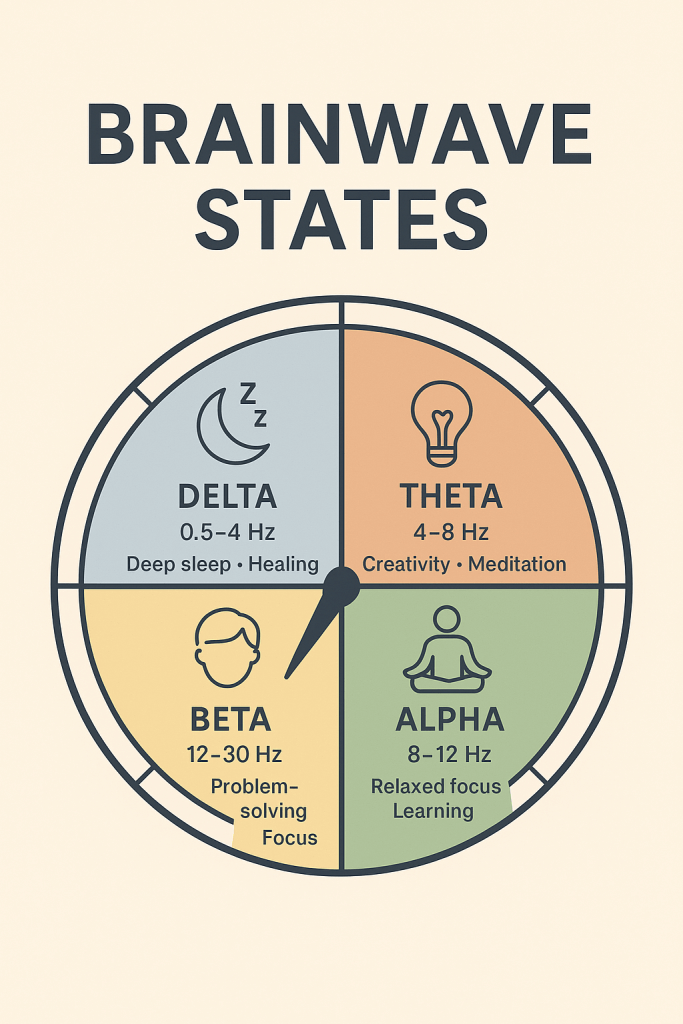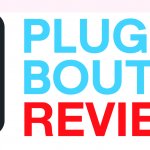🧠 Brainwave Entrainment and Healing Frequencies: How Sound Shapes the Mind
1. Introduction
Sound isn’t just music — it can literally change how your brain works. This process, called brainwave entrainment, happens when your brain synchronizes with external rhythms like sound, light, or vibration.
From ancient drumming rituals to Solfeggio frequencies and binaural beats, sound has long been used to shift consciousness. And now neuroscience is helping us understand why it works.
Whether you’re looking to sleep deeper, focus better, heal emotionally, or explore spiritual states — entrainment offers a gentle, science-backed pathway. No pills.
Just frequencies, patience, and headphones.
2. What Is Brainwave Entrainment?
At its simplest, brainwave entrainment is when your brain “locks onto” an external rhythm. Ancient shamans, monks, and healers used sound for altered states; today, scientists call it the frequency following response (FFR).
Your neurons are natural mimics. When exposed to a steady, rhythmic stimulus — like pulsing tones or flickering lights — they begin to fire in sync. It’s not magic. It’s biology.
Think of it like tuning a radio: your brain picks up the signal and adjusts its own frequency to match. The result? A shift in mental state — from anxious to calm, scattered to focused, awake to deeply asleep.
Related: What Are Solfeggio Frequencies? The Complete Guide

3. The Four Main Brainwave States
Your brain is never truly “off.” Even in deep sleep or deep meditation, it hums with electrical activity — rhythmic pulses we call brainwaves. These waves aren’t just background noise; they shape your state of consciousness, mood, and mental performance.
Neuroscientists categorize brainwave activity into five primary bands (though we’ll focus on the core four here), each associated with distinct mental and physiological states. When you use brainwave entrainment — whether through binaural beats, isochronic tones, or ambient Solfeggio music — you’re essentially whispering suggestions to your brain: “Hey, let’s hang out in Alpha for a while,” or “Time to dive into Theta and let the subconscious do its work.”
Let’s break down each state — what it feels like, when it shows up, and how you can intentionally access it.
Delta Waves (0.5–4 Hz): The Realm of Deep Restoration
Think of Delta as your brain’s “deep repair mode.” These ultra-slow waves dominate during dreamless sleep, especially in stages 3 and 4 of non-REM sleep. This is when your body releases growth hormone, repairs tissues, strengthens the immune system, and flushes metabolic waste from the brain (via the glymphatic system — yes, your brain has a cleaning crew!).
When you’re in Delta:
- You’re completely unconscious (unless you’re an advanced meditator or in a rare trance state).
- Your external awareness is nearly zero.
- Healing, regeneration, and hormonal rebalancing peak.
Why entrain to Delta?
If you struggle with insomnia, chronic fatigue, or recovery from illness or stress, Delta entrainment can help guide your nervous system into restorative rest — even if you don’t fall fully asleep. Many users report feeling “recharged” after just 20 minutes of Delta-frequency audio before bed.
Pro Tip: Pair Delta tracks with blackout curtains, cool room temps, and zero screens for maximum effect.
Theta Waves (4–8 Hz): The Gateway to Intuition and Inner Wisdom
Theta is the twilight zone — that hazy, dreamlike state between wakefulness and sleep. It’s where creativity blooms, memories surface, and emotional blockages dissolve. Children under 5 live mostly in Theta, which is why their imaginations run wild and they absorb information like sponges.
When you’re in Theta:
- You feel deeply relaxed, introspective, or in a light meditative trance.
- Vivid imagery, sudden insights, or emotional releases may occur.
- Hypnagogic (pre-sleep) and hypnopompic (post-sleep) states live here.
Why entrain to Theta?
Theta is perfect for:
- Emotional healing and shadow work
- Creative problem-solving and brainstorming
- Deep meditation and spiritual exploration
- Releasing anxiety, trauma, or limiting beliefs (often used in guided visualizations)
Many Solfeggio frequencies — like 528Hz (“DNA repair”) or 741Hz (“awakening intuition”) — are designed to gently nudge you into Theta, making them ideal companions for journaling, breathwork, or inner-child healing sessions.
Try This: Listen to a Theta binaural beat while free-writing or sketching — you might surprise yourself with what emerges.
Alpha Waves (8–12 Hz): The Sweet Spot of Relaxed Focus
Alpha is your brain’s “chill but alert” zone. It’s the mental state of sipping tea on a quiet morning, reading a novel without distraction, or effortlessly flowing through a yoga session. Alpha waves signal safety — your fight-or-flight system is off, and your parasympathetic (rest-and-digest) nervous system is online.
When you’re in Alpha:
- You feel calm, present, and mildly creative.
- Learning and memory encoding are optimized.
- Stress hormones like cortisol decrease.
Why entrain to Alpha?
Alpha is the golden frequency for:
- Reducing anxiety and overthinking
- Enhancing learning, reading comprehension, and language acquisition
- Preparing the mind for deeper meditation (it’s the “on-ramp” to Theta)
- Recovering from mental burnout or digital overload
Students, writers, and overthinkers swear by Alpha entrainment before study sessions or creative work. It’s like giving your brain permission to breathe.
Try This: Combine Alpha tones with nature sounds (rain, forest, ocean) for a double dose of calm.
Beta Waves (12–30 Hz): The Engine of Logic and Productivity
Beta is your brain’s “go mode.” It dominates when you’re solving problems, making decisions, engaging in conversation, or checking off your to-do list. While essential for daily functioning, too much Beta — especially high-Beta (18–30 Hz) — can lead to stress, anxiety, and mental chatter.
When you’re in Beta:
- You’re alert, focused, and externally oriented.
- Critical thinking and analytical skills peak.
- Too much = mental fatigue, overwhelm, or racing thoughts.
Why entrain to Beta?
Not all Beta is bad! Low-Beta (12–15 Hz), sometimes called “SMR” (Sensorimotor Rhythm), is ideal for:
- Sustained concentration (great for coding, writing, or studying)
- Improving attention in ADHD (some studies show promise)
- Staying awake and alert without caffeine
High-Beta entrainment is rarely used therapeutically — unless you’re trying to simulate stress for exposure therapy (not recommended for beginners!).
Caution: Avoid high-Beta tracks if you’re prone to anxiety. Stick to Alpha or low-Beta for “calm focus.”
Putting It All Together: Your Brainwave “Toolkit”
Think of these states not as rigid boxes, but as fluid zones your brain moves through naturally. The magic of entrainment is that you can gently guide your brain toward the state you need — whether that’s Delta for sleep, Theta for insight, Alpha for calm, or Beta for productivity.
And here’s the beautiful part: you don’t need to understand the science to benefit from it. Just press play, close your eyes, and let the frequencies do the whispering.

4. How Sound Influences the Brain
Brainwave entrainment works mainly through two core mechanisms: resonance and the frequency following response (FFR).
Resonance is the natural tendency of one vibrating system to sync with another — like a tuning fork causing a nearby string to hum at the same pitch. Your brain does this constantly, matching rhythms in your environment.
Methods of Entrainment
Binaural Beats
Requires headphones. Two slightly different tones are played in each ear (e.g., 200Hz left, 210Hz right). Your brain perceives the difference — 10Hz — and begins to synchronize to it. Ideal for deep meditation and sleep.
Isochronic Tones
No headphones needed. A single tone pulses on and off at the target frequency (e.g., 10 pulses per second = 10Hz). More pronounced and effective for focus and energy.
Solfeggio Frequencies
Ancient tones (like 396Hz, 528Hz, 852Hz) believed to carry healing or spiritual properties. Often layered into ambient music. Less about entraining brainwaves, more about emotional resonance and energetic alignment.
Related: 528Hz Frequency – The “Love Frequency” Explained
Important Note: Audible Sound vs. Brainwave Frequencies
Here’s where many people get confused:
- Brainwaves are very slow electrical rhythms in the brain (0.5–30 Hz for Delta–Beta).
- Sound frequencies we hear are much higher (typically above 20 Hz).
So, when you listen to a binaural beat for focus (say, to encourage Beta waves), the actual tones are audible — for example, 220 Hz in one ear and 230 Hz in the other. Your brain perceives the 10 Hz difference and starts to synchronize internally.
The brainwave itself isn’t “heard” — the sound is just a tool to guide your internal state.
5. Healing Benefits of Brainwave Entrainment
Brainwave entrainment isn’t just a novelty — it’s a tool that taps into your brain’s innate plasticity, gently guiding it toward states that support healing, focus, and inner peace. While individual results vary, thousands of users (and a growing body of research) report profound shifts — not from magic, but from consistent, intentional use.
Let’s explore what entrainment can truly offer — and how to harness it for your unique needs.
Stress Relief & Anxiety Reduction
In our hyper-connected world, chronic stress is the silent epidemic. Cortisol floods our systems, our nervous systems stay stuck in “fight-or-flight,” and our minds race even when we’re lying still.
Enter Alpha and Theta entrainment — your brain’s natural antidote.
Studies show that listening to Alpha-frequency binaural beats (8–12 Hz) for just 15–30 minutes can significantly lower cortisol levels and subjective anxiety scores. Theta waves (4–8 Hz) go even deeper — quieting the “default mode network” (the brain’s self-referential chatterbox) and allowing space for emotional release.
How to use it:
- Try Alpha tracks during work breaks.
- Use Theta before bed or during journaling to release emotional tension.
- Combine with breathwork (4-7-8 breathing) for amplified effects.
Better Sleep (Delta Entrainment)
If you’ve ever lain awake with a spinning mind, you know how elusive rest can be. Delta entrainment doesn’t “force” sleep — it invites your brain into the slow, restorative rhythm it craves.
Delta waves (0.5–4 Hz) dominate during deep, dreamless sleep — the phase where your body repairs cells, balances hormones, and clears neural toxins. Many insomnia sufferers show reduced Delta activity. Entrainment can help restore that natural rhythm.
A 2022 study in Frontiers in Human Neuroscience found that participants using Delta-frequency binaural beats fell asleep faster and reported improved sleep quality — without grogginess the next day.
Pro Tips:
- Start the track 30 minutes before bedtime.
- Keep volume low — it’s background ambiance, not foreground music.
- Avoid screens while listening; pair with dim lighting or an eye mask.
Enhanced Focus & Learning (Alpha / Low-Beta)
Forget chugging energy drinks. If you want laser focus without the crash, low-Beta (12–15 Hz) and high-Alpha (10–12 Hz) are your new best friends.
This “sweet spot” — sometimes called “relaxed concentration” — is ideal for studying, writing, coding, or any task requiring sustained attention without mental fatigue.
SMR (Sensorimotor Rhythm, 12–15 Hz) has even shown promise in ADHD research for improving impulse control and attention span.
Why it works:
- Alpha calms mental chatter.
- Low-Beta keeps executive function online.
- Together, they create a state of “flow” — where time dissolves and productivity soars.
Student Hack: Play a 15Hz isochronic tone track while reviewing flashcards. Many report better retention and less mental resistance.
Emotional Healing & Release (Theta)
Your subconscious holds memories, beliefs, and emotions that shape your behavior — often without your awareness. Theta entrainment opens the door to that inner world.
In Theta, your brain becomes highly suggestible — not in a manipulative way, but in a receptive, childlike state. This is why hypnotherapists, trauma therapists, and inner-child healers love this frequency band.
Paired with guided meditations or affirmations, Theta can help:
- Release old grief or resentment
- Rewire limiting beliefs (“I’m not good enough” → “I am worthy”)
- Access creative insights or intuitive guidance
Spiritual Exploration (Solfeggio Tones)
While science is still catching up, many users report profound spiritual experiences with Solfeggio frequencies — ancient tones like 396Hz (liberating guilt/fear), 528Hz (“DNA repair” or “miracle tone”), and 852Hz (returning to spiritual order).
These frequencies don’t entrain brainwaves directly. Instead, they’re believed to resonate with the body’s energy field, chakras, or biofield — creating a sense of alignment, peace, or transcendence.
Whether you view this as vibrational medicine or placebo-assisted mindfulness, the results speak for themselves: users describe feeling “lighter,” “more connected,” or “deeply at peace” after sessions.
Meditation Support (All Frequencies)
Struggling to quiet your mind? You’re not alone. Brainwave entrainment is like training wheels for meditation.
- Beginners: Start with Alpha (8–10 Hz) to ease into stillness.
- Intermediate: Shift to Theta (6–7 Hz) for deeper introspection.
- Advanced: Explore Delta or Gamma (30–100 Hz — not covered here) for transcendental states.
Many meditation apps now layer entrainment tones beneath nature sounds or chants — making it easier than ever to drop in, even on chaotic days.
Meditation Hack: Set a 20-minute timer with a Theta track. Focus on your breath — when your mind wanders, the tones will gently pull you back.
6. What the Science Says
Research supports entrainment for:
- Stress reduction — multiple studies confirm alpha/theta beats lower anxiety and cortisol.
- Sleep improvement — delta frequencies help some fall asleep faster and improve sleep architecture.
- Focus and working memory — mixed but promising results, especially with SMR (12–15Hz) for ADHD.
- Pain management — early studies show potential for reducing perceived pain during medical procedures.
But not all claims — especially spiritual or mystical — have strong scientific proof yet. That doesn’t mean they’re invalid — it just means science is still catching up to human experience.
The takeaway?
Use entrainment as a tool, not a cure-all. Pair it with healthy habits, professional care when needed, and self-compassion.
7. Practical Ways to Try Brainwave Entrainment
You don’t need a lab coat or expensive gear to start. Brainwave entrainment is one of the most accessible biohacks available today. Here’s how to begin — whether you’re tech-savvy or just want to press play and relax.
Stream Binaural Beat Tracks (Apps, YouTube, Spotify)
The easiest entry point. Thousands of free and premium tracks and apps exist across platforms.
Top Picks:
Brain.fm
One of the most scientifically advanced platforms. Uses AI to generate personalized focus, relaxation, or sleep tracks with embedded entrainment. Backed by peer-reviewed research. Offers free trial.
Insight Timer
Massive free library of meditations + entrainment tracks. Search “Theta binaural” or “Solfeggio 528Hz.” Includes timers, ambient sounds, and teacher-led sessions. Great for beginners.
Endel
Uses AI to generate real-time soundscapes based on time of day, weather, heart rate (via Apple Watch), and movement. Focus, Sleep, and Relax modes include subtle entrainment layers. Beautiful design, seamless UX.
Critical: Always use headphones for binaural beats. The effect relies on delivering different frequencies to each ear.
Try Solfeggio Meditation Music
Unlike binaural/isochronic tones, Solfeggio music is often melodic — think ambient pads, crystal bowls, or chanting layered over 528Hz or 432Hz tones.
Perfect for:
- Yoga or stretching
- Energy healing sessions
- Creating sacred space at home
Where to find it:
- Spotify: “Solfeggio Healing Frequencies” playlists
- YouTube: “528Hz Miracle Tone Full Album”
- Bandcamp: Independent artists creating immersive sound journeys
Attend Sound Baths for Immersive Sessions
If you crave a deeper, embodied experience, seek out a local sound bath. Practitioners use gongs, crystal bowls, tuning forks, and sometimes entrainment tones to create a 360° sonic environment.
You lie down, close your eyes, and let the vibrations move through you.
Many report:
- Deep emotional releases
- Physical tingling or warmth
- Time distortion (“Was that 20 minutes or 2 hours?”)
Pro Tip: Wear comfy clothes, bring a blanket, and hydrate afterward. Your body may release stored tension — water helps flush it out.
8. Tips for Safe & Effective Use
- Start with short sessions (10–15 minutes) — let your brain adapt gently.
- Use headphones for binaural beats — essential for the effect to work.
- Create a quiet, relaxing environment — dim lights, comfy seat, zero distractions.
- Avoid if you have epilepsy, heart conditions, or are pregnant — check with a doctor first.
- Don’t replace medical treatment with sound healing — it’s a complement, not a substitute.
9. Common Questions (FAQ)
Let’s tackle the most common questions.
How long does it take to work?
Some feel shifts within 5–10 minutes — a wave of calm, a quieting of mental chatter, or a sudden insight. Others need 3–5 sessions to notice consistent effects.
Why the difference?
- Brain sensitivity varies.
- Consistency matters more than duration. 10 minutes daily > 60 minutes once a week.
- Your intention and environment amplify results. Distraction = diluted effect.
Tip: Keep a simple journal. Note how you feel before/after. Patterns will emerge.
Can anyone use it safely?
Most healthy adults can — but proceed with caution if you have:
- Epilepsy or seizure disorders — flashing lights or rapid auditory pulses can trigger episodes.
- Pacemakers or heart conditions — while rare, consult your doctor. Some frequencies may affect heart rate variability.
- Pregnancy — limited research exists. Better safe than sorry — check with your OB/GYN.
- Psychiatric conditions (PTSD, schizophrenia, etc.) — entrainment can surface intense emotions. Use under guidance.
Never use while driving, operating machinery, or in situations requiring full alertness.
What’s the difference between binaural beats, isochronic tones, and Solfeggio frequencies?
Great question — they’re often confused!
Binaural Beats
- How it works: Play two slightly different frequencies in each ear (e.g., 200Hz left, 210Hz right → brain perceives 10Hz).
- Requires headphones? Yes — essential.
- Best for: Deep entrainment, meditation, sleep.
- Feels like: A subtle pulsing or humming “inside” your head.
Isochronic Tones
- How it works: Single tone turned on/off rapidly at target frequency (e.g., 10Hz = 10 pulses per second).
- Requires headphones? No — works with speakers.
- Best for: Focus, energy, quick sessions.
- Feels like: A rhythmic “beep… beep… beep” — more pronounced than binaural.
Solfeggio Frequencies
- How it works: Standalone tones (e.g., 528Hz, 396Hz) believed to carry healing or spiritual properties.
- Requires headphones? No — often enjoyed as ambient music.
- Best for: Emotional/spiritual work, energy balancing, background ambiance.
- Feels like: A resonant, soothing vibration — less “brain hack,” more “soul bath.”
Quick Guide: Use binaural for deep work, isochronic for focus, Solfeggio for vibe-setting.
Do I need special equipment?
- Binaural Beats → Headphones required. Any decent pair works — no need for “special” ones.
- Isochronic Tones → Speakers or headphones. Great for group sessions or background play.
- Solfeggio Music → Any speaker system. Phone, Bluetooth speaker, car stereo — all fine.
10. Conclusion
Sound can be medicine for the mind.
Brainwave entrainment isn’t about escaping reality — it’s about shaping it. Whether you’re seeking sleep, focus, emotional release, or spiritual connection, these tools offer a gentle, non-invasive way to guide your nervous system toward balance.
Science may not yet explain every mystical claim — but it doesn’t need to. Your experience is valid. If 10 minutes of Alpha waves melts your anxiety, or a 528Hz track makes you feel inexplicably lighter, that’s evidence enough.
Start small. Be consistent. Trust your inner compass.
Next Step:
Ready to dive deeper? Explore our Complete Guide to Solfeggio Frequencies — including the history, science, and how to use each tone for healing, manifestation, and spiritual awakening.









